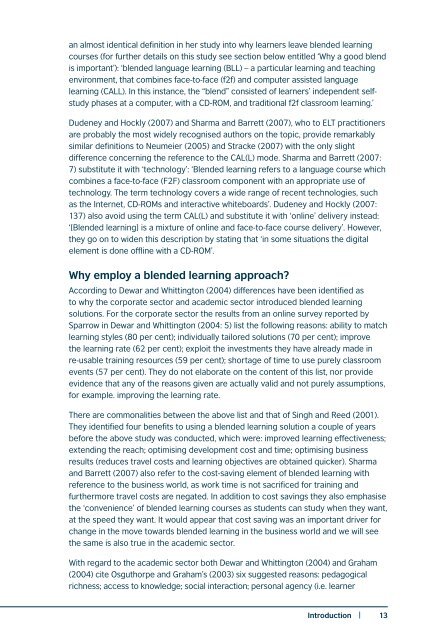Here - EnglishAgenda - British Council
Here - EnglishAgenda - British Council
Here - EnglishAgenda - British Council
You also want an ePaper? Increase the reach of your titles
YUMPU automatically turns print PDFs into web optimized ePapers that Google loves.
an almost identical definition in her study into why learners leave blended learningcourses (for further details on this study see section below entitled ‘Why a good blendis important’): ‘blended language learning (BLL) – a particular learning and teachingenvironment, that combines face-to-face (f2f) and computer assisted languagelearning (CALL). In this instance, the “blend” consisted of learners’ independent selfstudyphases at a computer, with a CD-ROM, and traditional f2f classroom learning.’Dudeney and Hockly (2007) and Sharma and Barrett (2007), who to ELT practitionersare probably the most widely recognised authors on the topic, provide remarkablysimilar definitions to Neumeier (2005) and Stracke (2007) with the only slightdifference concerning the reference to the CAL(L) mode. Sharma and Barrett (2007:7) substitute it with ‘technology’: ‘Blended learning refers to a language course whichcombines a face-to-face (F2F) classroom component with an appropriate use oftechnology. The term technology covers a wide range of recent technologies, suchas the Internet, CD-ROMs and interactive whiteboards’. Dudeney and Hockly (2007:137) also avoid using the term CAL(L) and substitute it with ‘online’ delivery instead:‘[Blended learning] is a mixture of online and face-to-face course delivery’. However,they go on to widen this description by stating that ‘in some situations the digitalelement is done offline with a CD-ROM’.Why employ a blended learning approach?According to Dewar and Whittington (2004) differences have been identified asto why the corporate sector and academic sector introduced blended learningsolutions. For the corporate sector the results from an online survey reported bySparrow in Dewar and Whittington (2004: 5) list the following reasons: ability to matchlearning styles (80 per cent); individually tailored solutions (70 per cent); improvethe learning rate (62 per cent); exploit the investments they have already made inre-usable training resources (59 per cent); shortage of time to use purely classroomevents (57 per cent). They do not elaborate on the content of this list, nor provideevidence that any of the reasons given are actually valid and not purely assumptions,for example. improving the learning rate.There are commonalities between the above list and that of Singh and Reed (2001).They identified four benefits to using a blended learning solution a couple of yearsbefore the above study was conducted, which were: improved learning effectiveness;extending the reach; optimising development cost and time; optimising businessresults (reduces travel costs and learning objectives are obtained quicker). Sharmaand Barrett (2007) also refer to the cost-saving element of blended learning withreference to the business world, as work time is not sacrificed for training andfurthermore travel costs are negated. In addition to cost savings they also emphasisethe ‘convenience’ of blended learning courses as students can study when they want,at the speed they want. It would appear that cost saving was an important driver forchange in the move towards blended learning in the business world and we will seethe same is also true in the academic sector.With regard to the academic sector both Dewar and Whittington (2004) and Graham(2004) cite Osguthorpe and Graham’s (2003) six suggested reasons: pedagogicalrichness; access to knowledge; social interaction; personal agency (i.e. learnerIntroduction | 13

















